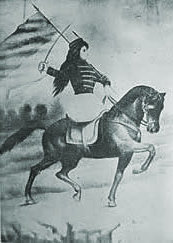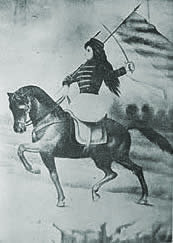
|
Women and Independence in Latin America An exploration of women's involvement in the Latin American Wars of Independence |

|

|
Women and Independence in Latin America An exploration of women's involvement in the Latin American Wars of Independence |

|
Other names: Marquesa de Santos
Gender:Female
Ethnic origen: White
Events:
| 1797 | - | Santos | - | Not applicable | - | She was born and grew up here, and was made the Marquesa de Santos. |
| 1822 | - | São Paulo | - | Unknown | - | She first met and became the mistress of Dom Pedro I in 1822. |
| 1823-1828 | - | Rio de Janeiro | - | Unknown | - | She lived here as the mistress of Pedro I. |
| 1867 | - | São Paulo | - | Unknown | - | Died |
Connections:
Brazilian royal familyBiography:
Domitila de Castro Canto e Mello was the most enduring and most notorious of the mistresses of the Brazilian Emperor D. Pedro I, rising to Pompadour-like status in the Brazilian court. She was born in São Paulo on the 27 December 1797. She first met Dom Pedro in the August of 1822 whist he was on his famous visit to São Paulo which culminated in the declaration of Independence on the banks of the Ipiranga. Domitila was 24 years old at the time and Pedro was a guest in her father’s house in Santos because her brother was a lieutenant and the soon-to-be Emperor’s favoured travelling companion (Macaulay, 123). They became lovers almost immediately. At this time Domitila was already married but separated from her husband Felício Pinto Coelho de Mendonça, with whom she had three children. In 1819 she had been accused of infidelity and had abandoned her husband, who had pursued her and attacked her with a knife (Macaulay, 168).
Pedro soon arranged for Domitila and her family to move to Rio de Janeiro to be nearer him, although the affair was kept a secret at first (Macaulay, 149). In April 1825 Pedro persuaded the unsuspecting Empress Leopoldina to select Domitila as one of her ladies-in-waiting and on his birthday in the October of the same year he created a number of new titles including the Viscountess of Santos for his mistress. It is around this time that Leopoldina began to realise the truth, whilst heavily pregnant with her son Pedro. A year later Domitila was elevated to the status of Marchioness and her father, sister and brother were also given titles. Through Pedro’s influence her husband was also persuaded not to contest divorce proceedings with the promise of land and a post. From then on the affair was conducted in an increasingly brazen manner and Domitila enjoyed a status equal to the Empress in the court (Macaulay, 190). Her first child with Pedro, Isabel, who was born in 1824, was legitimised and made the duchess of Goiás in 1826 and from then on addressed as “Sua Alteza” (Macaulay, 196). Moreover, Pedro insisted that she should be educated alongside the royal children. This situation caused Leopoldina much pain and humiliation. The affair, which was by now common knowledge, also did much to reduce the Emperor’s popularity and his behaviour was blamed for the Empress’s untimely death in 1826 (Macaulay, 211).
In May 1828 Pedro officially ended his relationship with Domitila, who resisted this move strenuously. It has even been suggested that she may have tried to shoot her own sister, thinking that Pedro wished to make her his mistress instead (Macaulay, 212). The real reason behind her banishment was that the Emperor wished to remarry and realised that Domitila had to removed if he was to secure a suitable wife from the European royalty. However, this quest for a second Empress of Brazil was not immediately successful, and in April 1829 Domitila was recalled to Rio and reinstated in her mansion opposite the Imperial Palace. This return to grace was not to last. Only four months later, and three months pregnant with their fifth child, she was sent back to Santos definitively when a new wife was finally found for Pedro in Amélie de Beauharnais von Leuchtenberg (Macaulay, 226). Domitila was never to see Pedro again and in 1842 she married the brigadier Rafael Tobias de Aguiar, with whom she had a further five children. She died on the 3 November 1867.
As the Emperor’s mistress Domitila sought and secured favours for friends and relatives who tended to be Brazilian-born and Liberals. As such José Bonifácio and his followers strongly disapproved of her presence in the court and suspected her of being part of a republican conspiracy (Macaulay, 174). Although she would have had little interested in supporting actions which might have overturned her position of favour and relative power, she was evidently interested in Liberal politics. After Pedro I’s abdication in 1831 she spent a considerable part of the money she had come by as his mistress on an insurrection in São Paulo.
References:
Macaulay, Neill (1986) Dom Pedro. The Struggle for Liberty in Brazil and Portugal, 1798-1834